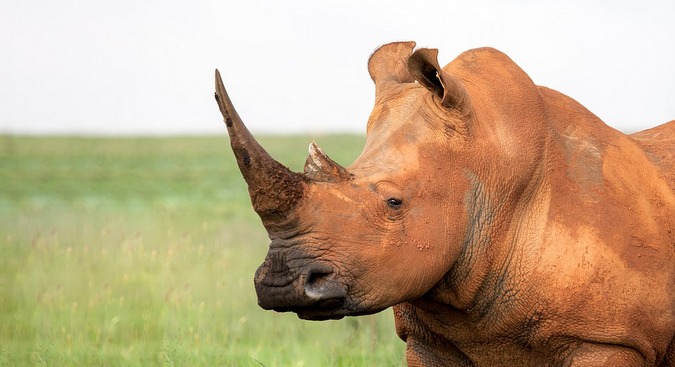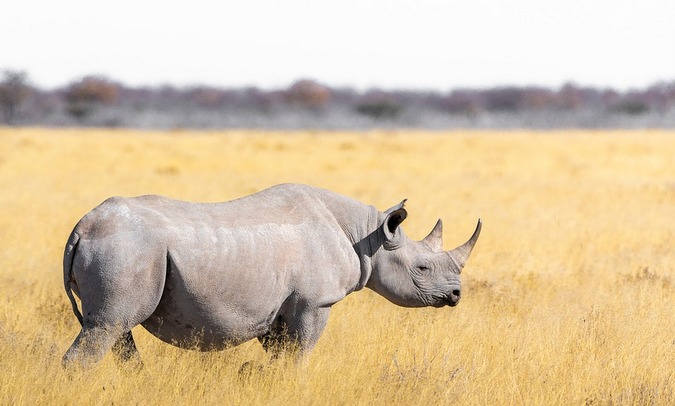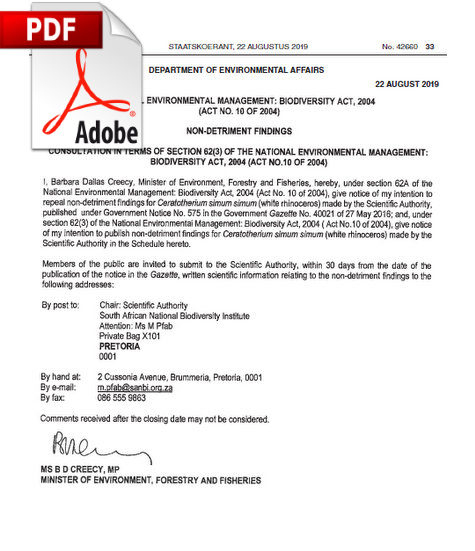
NEWS DESK POST by AG Editorial
The South African Minister of Environment, Forestry and Fisheries, Barbara Creecy, has requested public comment of a scientific nature on her proposal to:
1. Enable the international trade in white rhino horn by down-listing the white rhino on CITES.
2. Increase the annual quota of black rhinos for trophy hunting in South Africa, from the current five males to an unspecified number.
WHITE RHINOS
Currently, the South African population of white rhinos (Ceratotherium simum simum) have a split listing on CITES. They are listed on Appendix II of CITES, as regards permitting the international sale of live white rhinos that are bred in captivity for commercial purposes, and the export of trophy hunting trophies for non-commercial purposes. In all other forms (such as rhino horn), white rhinos are included in CITES Appendix I, and no international commercial trade is permitted.
After providing extensive background information, the minister concludes that “The export, for primarily non-commercial purposes, of rhinoceros horn that has been legally sourced, either through natural mortalities and/or horn harvest from wild populations, or from captive breeding facilities, will not be detrimental to the survival of the species in the wild provided that (1) the income derived from these exports contributes directly to the conservation of wild rhinoceros populations and (2) the captive breeding facilities meet the Scientific Authority’s approved criteria for the captive breeding of white rhinoceros” and “it is clear that C. simum simum does not meet the biological criteria for inclusion in Appendix I of CITES and a proposal to effect a straight Appendix II listing (i.e. without an annotation) can be considered.”

Put another way, the minister has recommended downgrading the protection afforded to the South African white rhino population under CITES from Appendix I to Appendix II, which will permit the export of rhino horn, in addition to the current permission to export live rhinos and hunting trophies.

BLACK RHINOS
Currently, the South African population of black rhinos (Diceros bicornis) is listed under CITES I, but with an annotation that permits the trophy hunting of five black rhino males per annum. No other international commercial trade is permitted.
After providing extensive background information, the minister concludes that “current exports of live animals and hunting trophies pose a low risk to the survival of this species in South Africa and should be allowed to continue” and “Legal hunting of black rhinoceros is beneficial to the conservation and protection of the species in South Africa, though the current low levels of trophy offtakes do not sufficiently incentivise the conservation of the species or its habitat. As there are surplus males that could be hunted, over and above the 3-4 trophy bulls hunted per year, the CITES export quota of five hunting trophies from adult males could be increased” and “Due to the Endangered status of the species in South Africa and the difficulties of regularly dehorning black rhinoceros, the export of black rhinoceros horn for primarily non-commercial purposes is not recommended at this stage.”
In other words, the minister has recommended that the number of black rhinos available for hunting annually should be increased, although she does not specify a number. She does not support the international trade of black rhino horn.
The two PDF documents below provide detailed reasoning by the minister for her two recommendations, including an extensive history of the conservation successes and failures of each species. We highly recommend that you read both documents before responding to the Minister, as only informed and scientific feedback stands a chance of being taken seriously.
You have until 22 September 2019 to send your feedback to the minister at:
Chair: Scientific Authority
South African National Biodiversity Institute
Attention: Ms M Pfab, Private Bag X101, Pretoria, 0001, South Africa
• Or by hand: 2 Cussonia Avenue, Brumeria, Pretoria, 0001, South Africa
• Or via email: m.pfab@sanbi.org.za
• Or by fax: (+27) 086-555-9863


To comment on this story: Login (or sign up) to our app here - it's a troll-free safe place 🙂.![]()








